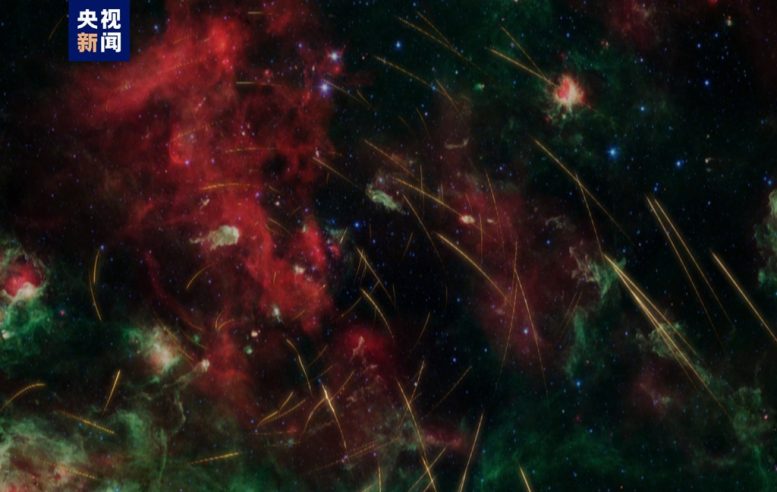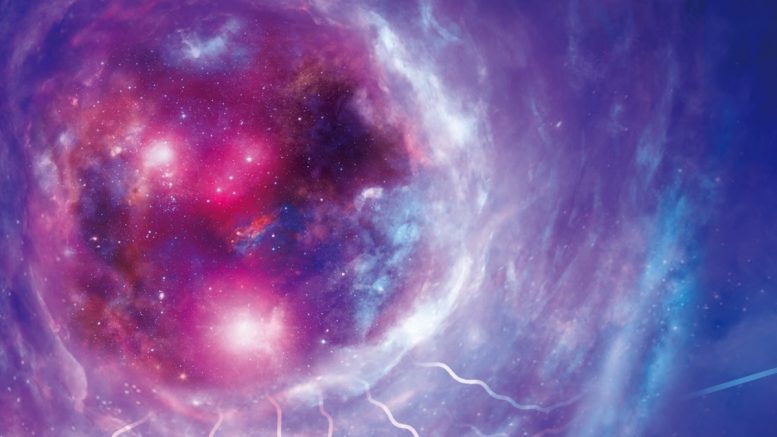LHAASO has discovered a super cosmic ray accelerator in a gamma-ray bubble in the Cygnus region, marking significant progress in understanding cosmic rays with energies above 10 PeV and their galactic origins. Rendering of a giant ultra-high energy gamma ray bubble structure.Image source: China Central Radio and Television
The Large High-Altitude Air Shower Observatory (LHAASO) discovered a huge ultra-high-energy gamma ray bubble structure in the Cygnus star formation region. This is the first time that the origin of cosmic rays with energy higher than 10 Peta has been discovered.15eV) has been discovered.
This result was published as a cover article in Chinese Science Bulletin February 26th.
The research was completed by the LHAASO collaboration group led by researcher Cao Zhen from the Institute of High Energy Physics, Chinese Academy of Sciences. Dr. Gao Chuandong, Dr. Li Cong, Professor Liu Ruoyu, and Professor Yang Ruizhi are the co-corresponding authors of this paper.
Cosmic rays are electrically charged particles from outer space, consisting mainly of protons. The origin of cosmic rays is one of the most important frontier issues in modern astrophysics. Measurements of cosmic rays over the past few decades have revealed a breakthrough in the energy spectrum (i.e., the distribution of cosmic ray abundance as a function of particle energy) around 1 PeV, which has been called the “inflection point” in the cosmic ray spectrum because of its similar shape in the knee joint.

A rendering of ultra-high-energy cosmic rays propagating in interstellar space.Image source: China Central Radio and Television
Scientists believe that cosmic rays with energy below “knee” originate from astrophysical objects inside the Earth. Milky Way, and the existence of the “knee” also shows that the energy limit of accelerated protons from most cosmic ray sources in the Milky Way is around a few PeV. However, the origin of cosmic rays in the “knee” region remains an unsolved mystery and one of the most interesting topics in cosmic ray research in recent years.
Discovery of the Super Cosmic Ray Accelerator
LHAASO discovered a giant ultra-high-energy gamma ray bubble structure in the Cygnus star formation region. There are multiple photons exceeding 1PeV inside the structure, with the highest energy reaching 2.5PeV, indicating the existence of a super cosmic ray accelerator. The bubbles continuously accelerate high-energy universe with energy up to 20PeV. ray particles and inject them into interstellar space. These high-energy cosmic rays collide with interstellar gas and produce gamma rays. The intensity of these gamma-ray photons is clearly related to the distribution of the surrounding gas, and the massive star cluster near the center of the bubble (OB Association, OB2 Cygnus) is the most promising candidate for a super cosmic ray accelerator. Cygnus OB2 is composed of many young, hot, massive stars with surface temperatures exceeding approximately 35,000°C (O-type stars) and 15,000°C (B-type stars).

A large-scale high-altitude wind and rain observation station located in Daocheng County, Sichuan Province, Southwest China.Image source: China Central Radio and Television
The radiant luminosity of these stars is hundreds to millions of times that of the sun. The huge radiation pressure blows away the surface material of the stars, forming dynamic stellar winds with speeds of up to thousands of kilometers per second. The collision of stellar winds with the surrounding interstellar medium and the violent collisions between stellar winds create an ideal place for the efficient acceleration of particles. This is the first super cosmic ray accelerator identified to date. As the observation time increases, LHAASO is expected to detect more super cosmic ray accelerators and solve the mystery of the origin of cosmic rays in the Milky Way.
LHAASO observations also show that the super cosmic ray accelerator inside the bubble significantly increases the density of cosmic rays in the surrounding interstellar space, far exceeding the average level of cosmic rays in the Milky Way. The spatial excess of density extends even beyond the observed range of the bubble, providing a possible explanation for the excess emission of diffuse gamma rays from the galactic plane previously detected by LHAASO.
Professor Elena Amato, a well-known astrophysicist at the Italian National Institute of Astronomy and Physics (INAF), emphasized the overall impact of this discovery on the origin of cosmic rays. She also commented that these results “not only impact our understanding of diffuse emission, but also have very relevant implications for our description of cosmic ray (CR) transport in the Milky Way.”
Reference: “Ultra-high-energy gamma-ray bubbles powered by Super PeVatron,” LHAASO Collaboration, December 23, 2023 Chinese Science Bulletin.
DOI: 10.1016/j.scib.2023.12.040
#Super #cosmic #ray #accelerator #Chinese #astronomers #discover #giant #ultrahigh #energy #gamma #ray #bubbles
Image Source : scitechdaily.com
